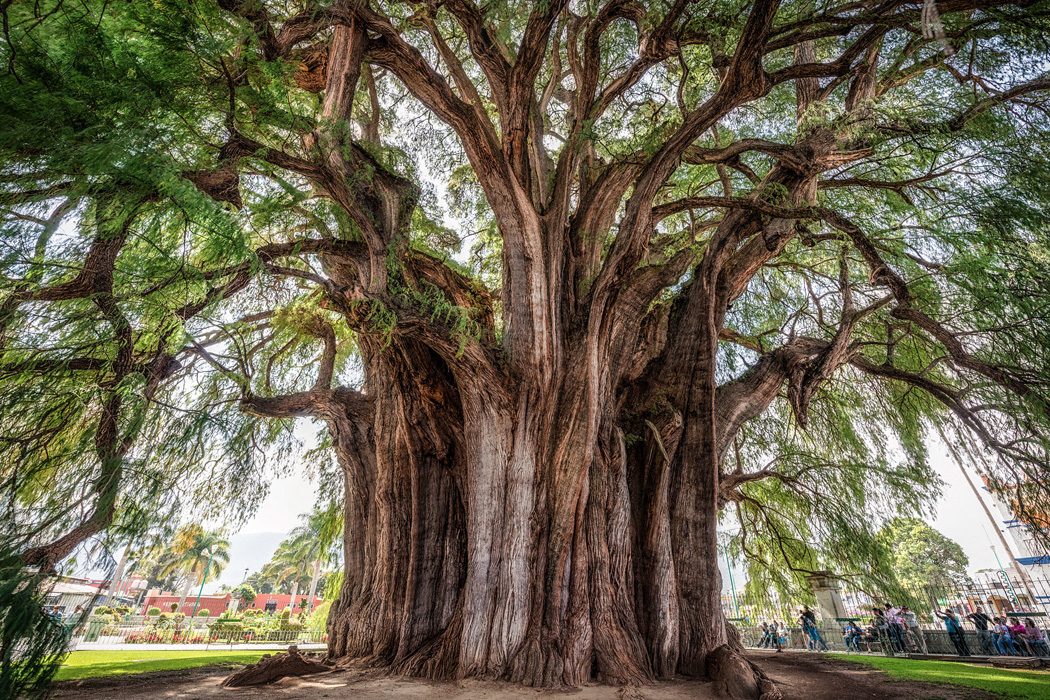Editor’s note: Each Thursday, we feature a throwback piece from Topology’s predecessor, catapult magazine. In this essay from 2009, Josh Maclvor-Anderson shares a tale of pilgrimage to the Montezuma Cypress known as El Àrbol del Tule.
Back in the States, I’m an arborist, a person tasked with the care of trees, paid to prune them and remove them and make them as happy and healthy as a customer’s checking account will allow. Some days, swinging around in trees with a chainsaw is simply work, a tedious repetition of early mornings and lots of bumps, bruises and sunburns. But other times, when the breeze hits me at a hundred feet and comically impossible cherry blossoms explode all around me, it is pure pleasure. Sometimes it feels like the best job in the world.
These back-home tethers are what bind me to my current adventure, heading east out of Oaxaca City, Mexico to the “unremarkable” village of El Tule—a standard pueblo with a church or two, a market, lots of fruit. The only thing that distinguishes El Tule is a tree. But it is a very big tree. In fact, it is said to be the largest single biomass on the planet, although I’ve heard something about aspen roots and algae, and then there are all those sequoias tickling the clouds in California.
The details don’t really matter. For me, a person whose relationship with trees has been more intimate than most, this trip is still something of a pilgrimage, a journey to center of the tree-person’s universe, a homecoming for my wandering arboreal heart.
It’s a little embarrassing, but pulling up to our bus stop and seeing the giant green canopy dwarfing the adjacent church that it outdates by a few millennia is making me giddy. I’m yanking on my wife’s arm, pulling her along the sidewalk like a child on a toy store mission.
“That Montezuma Cypress is no joke,” I say, smiling, squinting from across the street and struggling to speak with the eloquence I feel the tree deserves. “That tree is the real deal.”
I talk as if other trees I’ve known have suddenly become facsimiles, mere seedlings from this, the mother tree, the Mecca tree, the fulcrum tree around which all other trees bend and sway.
It is gargantuan. For three pesos each we are allowed to circle the thing, a long walk indeed, staring at its enormity from every angle except – I feel the urge to climb it like an addict in a supermarket full of fixes – from above. I am in awe. I’ve never seen such a structure, its enormous root flares like the flying buttresses of Notre Dame, its branches tangling into the sky like the muscled arms of a storybook kraken. It is so big. My words for enormous are short-circuiting.
And despite its size – 58 meters of girth and 42 meters of height – it exudes such delicacy. Its soft, fernlike branches sweep almost to the ground, down to my fingertips, extending all the way past the iron fence to the sidewalk to greet even those who can’t afford the three-peso admission. What a tree, I think to myself as I yank on the tips of its branches. Benevolent, kind, accommodating…this is the best tree in the world.
But I have secret thoughts. Ones that, if they could be seen in a cloud of text above my head, would probably get me exiled from El Tule. Perhaps all of Mexico. I’ve already begun cutting the tree down in my mind, choosing the best leverage points for removing its immense branches, imagining the entire thing as a scaffolding from which I could dismantle one of the world’s largest single biomasses, limb by giant limb.
This is part of the sickness of my vocation. Having pruned a thousand trees and removed just as many, it’s easy to view them merely as challenges, problems to be solved, pay checks. I prune the trees in the medians of highways when I blast by at seventy miles an hour.
But this tree comes with warnings. The green iron fence keeping me a safe distance from its trunk is hung with signs that say in multiple languages, “Please don’t cut my branches. I am a living thing.” German, English, Spanish. It’s as if they were hung here just for me, as if they know my past. I can feel the cold, icy stares of the policia turistas on my back, and I can’t help but wonder if they can see who I am by the scars on my forearms, the dried tree sap from back home still crusted into my jeans, the faint smell of chainsaw gas following me wherever I go like cheap cologne.
“I’m sorry,” I say to the tree, penitently, a declaration of guilt in the church yard to a different kind of confessor. “I had bills to pay.”
I’m racking up quite a record of the “world’s largest.” I’ve seen the largest bronze doors in the world—7.5 tons each, twenty-four feet high, twelve inches thick. They live in Nashville attached to a replica of the Parthenon.
I’ve seen the largest cross in the western hemisphere, rocketing 19 stories into the sky on the outskirts of Amarillo, Texas in a town called Groom (although I’ve heard it has been eclipsed by a cross in Illinois that’s eight feet higher).
And although I’ve never stopped, I’ve seen billboards for the largest groundhog in the world. The interstate signs are some of the precious little scenery dotting the Kansas countryside. The friends who stopped were disappointed to find that the animal was not, in fact, living, but only a shabby replica of a groundhog, constructed of plaster and chicken wire.
But the tree of El Tule is definitely alive. It is said to be two thousand years old, which means it was already photosynthesizing when Jesus was hanging limp and broken on his cross. Of course it is two thousand years old mas o menos, “more or less,” which, like many things here in Mexico, means its age is open to interpretation. “I’ll get there at 6:00 p.m. (mas o menos),” means sometime before eight. “It’ll take you an hour (mas o menos),” means more than two and less than four.
But even with a few more or a few less years, the thing is ancient. Older than New York City, older than the Liberty Bell and, if my spontaneous math is correct, older than all of the houses I’ve ever lived in combined.
And what’s astounding beyond the tree’s size and age is all the life that exists outside of its own vascular system. All the birds that have nested in the peels of its bark, and the bees, too. The tree of El Tule is loud—so much life swarming and perched around its canopy. There are various mosses growing symbiotically from its limbs and then there are all of us people, circling its trunk like planets around a sun, snapping pictures and gawking. This goliath is indeed a universe, buzzing with energy and life, dying and regenerating and creating its own gravitational pull around which so many living things, including me, happily orbit.
It is busier than usual, today. We’ve come here during Semana Santa, one the holiest of Mexican holidays and one of the most popular, right up there with Navidad—a time when vacationers bottle-neck through the streets and into the famous cathedrals of Oaxaca. The church of El Tule, too, is bustling with worshipers and pilgrims and tourists from Germany and Ohio. There is a woman on her knees in front of a plastic statue of Christ, thorns tearing open his flesh and blood trickling into his eyes. She is praying with real fervency, crossing herself, pressing her small dark hand to her lips and rocking back and forth. Walking past her with a grin is a man wearing a cowboy hat, the kind they sell to tourists back in the central market. His camera dangles from one hand—his fingers working the cord like prayer beads—and with the other he points out saints and flowers and paintings to his wife. A big, sincere smile.
This is one of the dramas of the modern state of Oaxaca. Places of piety, of beauty, all do double duty here. There are different plays being acted out on the same stages, the plots of which, at times, tenuously intersect. Some have come to this place to worship and pray, while others have come to look at a tree and take pictures. Still others, the entrepreneurs, have recognized both pilgrimages and have set up shop, selling crucifixes made of palm fronds to the faithful and silk-screened t-shirts to tourists.
I suppose we’re all looking for something. Some of us want to be wowed and awed, to see big things and take their pictures. Some want to make a living, to take advantage of the big-thing-seekers and put food on the table. And others want to connect to an invisible deity, to make sense of our world by placing control of it in the pierced hands of a God-man who knows what it’s like to suffer.
We’ve all come to the same place today. We’ve all gathered together under the broad canopy of El Tule, its dappled shadow pouring evenly over the church and the hawkers and the tourists. The complex social buzz of Semana Santa mixes with the bees nesting in the bark. Women pray. Cameras flash. Children rejoice as their fathers make another sale and somewhere, in the highest limbs of the tree, a symphony rings in the throats of the birds.
My pencil tip breaks against the page. A thousand others could express this better. How does one truly describe a universe, anyway? How does one capture in words a continent of a tree with giant kraken arms swaying gracefully in the breeze? Every time I glance at it I can feel the adjectives traffic-jamming on my tongue.
I will recede. I will step away and defer to the woman and her young son who stood by me at the base of the tree, fresh victims for my ongoing, self-devised Spanish lessons. Having built up some courage, I asked her what she thought of the giant thing. After hearing the inarticulate mess that came out of my mouth she paused, smiled, and said in perfect, profound English: “It’s beautiful. It’s big. It’s old.”




